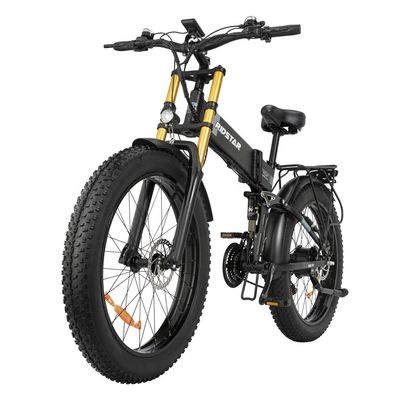Introduction To Electric Bikes
Electric bikes, also known as e-bikes, have surged in popularity in recent years, transforming the landscape of personal transportation and recreational cycling. This surge is propelled by technological advancements, environmental concerns, and changing urban mobility needs. In this comprehensive exploration, we will delve into the evolution, mechanics, benefits, challenges, and future prospects of electric bikes, providing a thorough understanding of their significance in the modern world.
1. Evolution of Electric Bikes:
Electric bikes have a rich history that dates back to the late 19th century. The first patents for electric bicycles emerged in the 1890s, but it wasn't until the late 20th century that they began to gain traction. Early electric bikes featured bulky lead-acid batteries and rudimentary electric motors, limiting their practicality and appeal.
However, advancements in battery technology, motor efficiency, and lightweight materials in the late 20th and early 21st centuries catalyzed the evolution of electric bikes. The introduction of lithium-ion batteries, brushless motors, and lightweight frames revolutionized the performance and aesthetics of e-bikes, making them more accessible and appealing to a broader audience.
2. Mechanics of Electric Bikes:
Electric bikes operate on a simple yet sophisticated mechanism that integrates traditional bicycle components with electric propulsion systems. At the heart of every e-bike is an electric motor and battery. The motor provides assistance to the rider's pedaling efforts, augmenting their speed and power output.
There are two main types of electric bike motors: hub motors and mid-drive motors. Hub motors are integrated into the wheel hub, providing direct propulsion, while mid-drive motors are mounted on the bike frame near the pedals, leveraging the bike's gears for optimized performance.
The electric motor is powered by a rechargeable battery, typically mounted on the frame or integrated into the bike design. Lithium-ion batteries are the most common choice due to their high energy density, lightweight, and long lifespan. The battery capacity determines the range of an electric bike, with larger batteries offering extended riding distances.
E-bikes are equipped with a control system that allows riders to adjust the level of electric assistance. This control panel often includes settings for different assist levels, throttle activation, and battery status indicators. Riders can choose between pedal-assist mode, where the motor provides assistance proportional to the rider's pedaling input, or throttle mode, where the motor operates independently of pedaling.
3. Benefits of Electric Bikes:
Electric bikes offer a myriad of benefits that contribute to their growing popularity:
-
Convenience: E-bikes provide a convenient and efficient mode of transportation for commuting, errands, and leisure rides. They enable riders to cover longer distances with less effort, reducing travel time and fatigue.
-
Accessibility: Electric bikes are accessible to a wide range of riders, including those with limited physical fitness or mobility challenges. The electric assistance levels can be adjusted to accommodate varying fitness levels and riding conditions.
-
Environmental Sustainability: Electric bikes are eco-friendly alternatives to conventional vehicles, emitting zero tailpipe emissions and reducing carbon footprint. They promote sustainable transportation solutions and contribute to cleaner air and reduced traffic congestion in urban areas.
-
Health and Fitness: Contrary to common misconceptions, electric bikes still require physical exertion from the rider. They encourage outdoor activity, improve cardiovascular health, and promote active lifestyles.
-
Cost-Effectiveness: While the initial cost of purchasing an electric bike may be higher than a traditional bicycle, the long-term savings on fuel, maintenance, and parking expenses make them a cost-effective transportation option.
-
Versatility: Electric bikes come in various styles and designs, catering to different preferences and riding needs. Whether for commuting, recreational cycling, or off-road adventures, there's an e-bike model suited to every rider.
4. Challenges and Considerations:
Despite their numerous benefits, electric bikes face certain challenges and considerations:
-
Regulatory Framework: Regulations governing the use of electric bikes vary by region and jurisdiction. Some areas have strict laws regarding e-bike classification, speed limits, and where they can be ridden. Navigating these regulations can be confusing for riders and manufacturers alike.
-
Infrastructure and Safety: The growing popularity of electric bikes necessitates infrastructure improvements to accommodate their presence on roads and bike lanes. Additionally, safety concerns arise regarding interactions between e-bikes, pedestrians, and other vehicles, highlighting the need for education and awareness campaigns.
-
Battery Range and Charging Infrastructure: While battery technology has advanced significantly, range anxiety remains a concern for some e-bike riders. Limited battery range and the availability of charging stations may restrict long-distance travel or require careful planning.
-
Maintenance and Service: Electric bikes require regular maintenance to ensure optimal performance and battery longevity. Riders may encounter challenges finding qualified technicians or specialized service centers capable of servicing e-bike components.
5. Future Prospects:
The future of electric bikes is promising, with ongoing innovations and advancements poised to further enhance their appeal and functionality:
-
Technological Innovations: Continued advancements in battery technology, motor efficiency, and smart connectivity features will improve the performance, range, and user experience of electric bikes.
-
Integration with Smart Cities: Electric bikes are integral to the concept of smart cities, offering sustainable and efficient transportation solutions for urban mobility challenges. Integration with smart infrastructure, such as bike-sharing programs and intelligent traffic management systems, will further enhance their utility and accessibility.
-
Customization and Personalization: Manufacturers are increasingly offering customizable e-bike options, allowing riders to tailor their bikes to their specific preferences and riding styles. This trend towards personalization will continue to drive consumer demand and innovation in the e-bike industry.
-
Expansion of E-Bike Market: The global electric bike market is expected to continue its exponential growth, driven by increasing awareness of environmental issues, urbanization trends, and shifting consumer preferences towards sustainable transportation options.
In conclusion, electric bikes represent a revolutionary evolution in personal transportation, combining the convenience of motorized vehicles with the health benefits and eco-friendliness of cycling. While they face certain challenges and considerations, the benefits they offer in terms of accessibility, sustainability, and versatility make them a compelling choice for riders worldwide. With ongoing technological advancements and supportive policy initiatives, electric bikes are poised to play a pivotal role in shaping the future of urban mobility and sustainable living.


